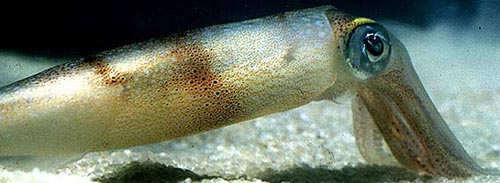Doryteuthis
Michael Vecchione and Richard E. Young


This tree diagram shows the relationships between several groups of organisms.
The root of the current tree connects the organisms featured in this tree to their containing group and the rest of the Tree of Life. The basal branching point in the tree represents the ancestor of the other groups in the tree. This ancestor diversified over time into several descendent subgroups, which are represented as internal nodes and terminal taxa to the right.

You can click on the root to travel down the Tree of Life all the way to the root of all Life, and you can click on the names of descendent subgroups to travel up the Tree of Life all the way to individual species.
For more information on ToL tree formatting, please see Interpreting the Tree or Classification. To learn more about phylogenetic trees, please visit our Phylogenetic Biology pages.
close boxIntroduction
Doryteuthis species are the common inshore squids of American waters. Several species (e.g., D. pealeii, D. opalescens) are targets of substantial fisheries. The genus is defined by geography and the absence of specific modifications that define other genera.
Brief diagnosis:
A loliginid ...
- with fins in adults rhomboidal, longer than broad, (length <70% of ML); mantle elongate, pointed posteriorly; cement body of spermatophore short.
- with a distribution in waters off the Americas.
Characteristics
- Arms
- Hectocotylus:
- Ventral crest absent.
- Proximal suckers unmodified.
- Distal suckers of reduced size, sucker stalks elongated to form papillae in either dorsal or both dorsal and ventral series.
- Tentacles
- Tentacular clubs expanded, suckers in four series.
- Head
- Beaks: Descriptions can be found here: Lower beak; upper beak.
- Beaks: Descriptions can be found here: Lower beak; upper beak.
- Fins
- Fins extend to posterior tip of mantle.
- Photophores
- Photophores absent.
- Viscera
- Eggs less than 4 mm.
- Spermatophore cement body short.
Comments
The genus is subdivided into three subgenera, two of which are named, D. (Doryteuthis) and D. (Amerigo). Species of D. (Doryteuthis) have the modified portion of the hectocotylized arm extending to the arm tip, and the edges of gladius vane are thickened, while in D. (Amerigo) neither of these conditions hold. Doryteuthis sanpaulensis does not belong in either of these subgenera and was considered by Vecchione et al. (2005) to be the sole recognized species in an undescribed subgenus.


Figure. Oral view of the distal region of the hectocotylus of D. (Doryteuthis) plei, 105 mm ML, off S.E. USA, preserved. Photograph by R. Young.
Although we tend to think of squids as constantly swimming, D. (A.) pealeii is often observed sitting on the ocean floor or the bottom of an aquarium.
References
Vecchione, M., E. Shea, S. Bussarawit, F. Anderson, D. Alexeyev, C.-C. Lu, T. Okutani, M. Roeleveld, C. Chotiyaputta, C. Roper, E. Jorgensen and N. Sukramongkol. 2005. Systematics of Indo-West Pacific loliginids. Phuket Mar. Biol. Cent. Res. Bull. 66: 23-26.
Title Illustrations

| Scientific Name | Doryteuthis pealeii |
|---|---|
| Specimen Condition | Live Specimen |
| View | Dorsal |
| Image Use |
 This media file is licensed under the Creative Commons Attribution-NonCommercial License - Version 3.0. This media file is licensed under the Creative Commons Attribution-NonCommercial License - Version 3.0.
|
| Copyright |
©
Michael Vecchione

|
About This Page
Michael Vecchione

National Museum of Natural History, Washington, D. C. , USA
Richard E. Young

University of Hawaii, Honolulu, HI, USA
Correspondence regarding this page should be directed to Michael Vecchione at
vecchioneM@si.edu
Page copyright © 2018
 Page: Tree of Life
Doryteuthis .
Authored by
Michael Vecchione and Richard E. Young.
The TEXT of this page is licensed under the
Creative Commons Attribution-NonCommercial License - Version 3.0. Note that images and other media
featured on this page are each governed by their own license, and they may or may not be available
for reuse. Click on an image or a media link to access the media data window, which provides the
relevant licensing information. For the general terms and conditions of ToL material reuse and
redistribution, please see the Tree of Life Copyright
Policies.
Page: Tree of Life
Doryteuthis .
Authored by
Michael Vecchione and Richard E. Young.
The TEXT of this page is licensed under the
Creative Commons Attribution-NonCommercial License - Version 3.0. Note that images and other media
featured on this page are each governed by their own license, and they may or may not be available
for reuse. Click on an image or a media link to access the media data window, which provides the
relevant licensing information. For the general terms and conditions of ToL material reuse and
redistribution, please see the Tree of Life Copyright
Policies.
- First online 25 January 2006
- Content changed 02 September 2010
Citing this page:
Vecchione, Michael and Richard E. Young. 2010. Doryteuthis . Version 02 September 2010 (under construction). http://tolweb.org/Doryteuthis/23877/2010.09.02 in The Tree of Life Web Project, http://tolweb.org/









 Go to quick links
Go to quick search
Go to navigation for this section of the ToL site
Go to detailed links for the ToL site
Go to quick links
Go to quick search
Go to navigation for this section of the ToL site
Go to detailed links for the ToL site